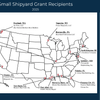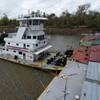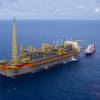Marine oil spills are subject to natural processes, which alter oil's physical and chemical properties. These factors ? as well as the type of oil spilled, the magnitude of the spill, and the physical conditions of the spill site ? determine the appropriate response for spill cleanup. Response options include mechanical recovery, chemical treatment and in-situ burning.
Every spill scenario is unique and constantly changing. Careful assessment by experienced personnel is required for effective response performance. Natural spreading of the oil spill is a major factor in determining the response option most likely to succeed. The number and availability of personnel and equipment is also a major consideration.
Mechanical recovery requires the depth or thickness of the oil on the sea is adequate to 'skim' the oil. Oil skimmers remove the oil from the surface of the water. There are several skimming methods based on the design of the skimming equipment. They include weir skimmers, a simple device, which floats on the surface with an opening adjusted to allow the oil to flow into the device and be pumped away. The disadvantage of this technique is the large volume of water skimmed along with the oil. Drum, disc and brush skimmers pick up the oil, which is collected and pumped away with the distinct logistical advantage of having less water in the skimmed oil. Temporary containers receive the oil and it is hauled away for appropriate disposal.
Skimming operations also require the oil be contained and stopped from spreading to maintain the thickness required to continue skimming operations. A containment boom used for this purpose is deployed from response vessels and typically towed in a U configuration. This process captures the oil and allows it to be skimmed from the apex of the U. Forward progress of the tow vessels collects more oil and stacks it in the apex for skimming. The containment boom typically has flotation chambers, a vinyl skirt extending below the surface and a chain ballast for stability. The flotation section of the boom can be made of foam or filled with air as it is deployed.
Barges or other vessels with tankage capabilities are required to accompany the skimmers to receive the skimmed oil, which creates a logistical problem in large volume spill scenarios.
When spills have spread over large areas and the oil is thin on the surface, chemical treatment is generally preferred. Dispersants are sprayed over the thin oil layer and the oil is 'absorbed' into the water column. Debate on the environmental impact of oil and dispersant in the water column is ongoing.
Dispersants are applied by spray equipment mounted on boats of various sizes, small fixed wing aircraft and helicopters. For large incidents, bigger fixed wing aircraft can be used. The logistical advantages of dispersant use include the absence of retrieved oil, meaning no disposal is required. Responders can often get to the spill site more quickly and marine sites are easily accessed by air.
For very large oil spills threatening to inflict significant environmental damage over large areas, in-situ burning is a more recently developed response option. In-situ burning is under intense study by the USCG, the Canadian Coast Guard, and the U.S. Navy and has been approved as an effective response tool.
The advantages of in-situ burning are high oil elimination rate, high efficiency, minimal disposal and cleanup logistics, no storage required for recovered water and oil, low cost and minimal environmental impact. Studies done on the smoke plume from in-situ burning reveal surprisingly small impacts on the environment.
Fire-proof containment booms are required for effective in-situ burning and several models are available. Many tests with fire boom have been completed and research on refined in-situ burn techniques continues. Limitations governing in-situ burning as a response option include volatility and emulsification. If the light ends of the spilled oil have evaporated with age after the spill incident, the oil may not ignite or burn well. If wave action has emulsified the oil, responders may encounter similar problems.
Marine spill responders often utilize a combination of response options in combating oil spills. Options are generally based on weather conditions, availability of equipment and the state of the spilled oil. As with any emergency response, elapsed time between the incident and the beginning of response operations is crucial.
Dave Muse is marketing director at Elastec/American Marine, a manufacturer of environmental equipment. http://www.elastec.com He can be contacted at 618-382-2525
Sponsored Content
Safer Starts Here: Build Ships, Protect Crews

Featured videos

Maritime Energy Transition: Cummins Focuses on Methanol

Meet the Volvo Penta IPS Electric (E)

Efficient Maritime Operations Transcend Data; Intelligence is Key
July 2025
 Read the Magazine
Read the Magazine

 Read the Magazine
Read the Magazine
This issue sponsored by:

Schottel Mark’s 75th Anniversary of the RudderPropeller
Subscribe for
Maritime Reporter E-News
Maritime Reporter E-News is the maritime industry's largest circulation and most authoritative ENews Service, delivered to your Email five times per week







